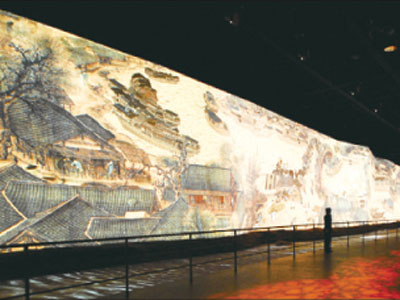 |
Large Medium Small |

BEIJING — Visitors to Shanghai Expo have a chance to see a modern version of the giant scroll painting Along the River During the Qingming Festival in the China Pavilion.
Painted by Song Dynasty artist Zhang Zeduan (1085-1145) and known as “China’s Mona Lisa”, it has been converted into a three-dimensional image on a digital screen measuring 100 meters by six meters.
The river in the picture appears to be flowing. People and cattle seem to be standing next to audiences. Expanded by 10 times, the digital version of the painting has special sound and light effects, and change constantly.
The image was created by Beijing company Crystal CG. Established in 1995, crystal CG is on its way to becoming one of the top 3D modeling, simulation and visualization companies in Asia.
The company’s clients include the Chinese government, military and domestic real estate businesses. According to Fu Yingying, market manager in the marketing promotion department of the company, Crystal CG is devoting all its energy to the Shanghai Expo.
Crystal CG was also involved in the 2008 Beijing Olympics. During the opening ceremony, a 147-meter digital scroll painting was unfolded. Chinese wash and ink paintings blossomed like flowers on it, telling the long history of the country. Crystal’s projects included the 492-meter ribbon screen atop the stadium and the images on live-broadcast screens.
The company now has 2,200 employees and is the only one of its size. Most 3D companies are small studios and workshops with perhaps 30 people.
Zeng Shuyu, who opened Lighting World Digital Technique Co Ltd three years ago, said these small companies started with architectural visualization projects for real estate companies. “These projects are comparatively profitable. In China there are enough projects, but generally they pay a low price, which limits the ability of these companies to produce better products,” said Zeng.
On average, the cost of China’s 3D design works is 2,000 to 3,000 yuan per second. A few clients provide a top budget of 7,000 to 8,000 yuan per second.
Now, Zeng’s company mainly provides special visual effects for films and TV dramas. Her clients are mostly local companies but some foreign corporations commission special effects and processing.
Because of the low budget, many domestic 3D creations are comparatively not as skilful as those made overseas.
Xiao Yongliang, deputy dean of the School of Arts and Communication at Beijing Normal University, who also used to work at Blue Sky Studio, says the biggest problem is the lack of 3D software developing talent. “At Disney, Pixar or Dreamworks, there are special teams developing software to make these effects but in China we only use foreign techniques. This makes us fall far behind these giants,” Xiao said.